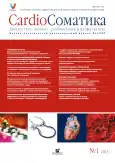Self-monitoring of blood glucose as a basis for diabetes management
- Authors: Mayorov A.Y.1, Melnikova O.G1, Filippov Y.I1
-
Affiliations:
- FSBI Endocrinology Research Centre of Ministry of Health of Russia
- Issue: Vol 4, No 1 (2013)
- Pages: 47-54
- Section: Articles
- URL: https://journals.rcsi.science/2221-7185/article/view/45036
- DOI: https://doi.org/10.26442/CS45036
- ID: 45036
Cite item
Full Text
Abstract
Keywords
Full Text
##article.viewOnOriginalSite##About the authors
A. Yu Mayorov
FSBI Endocrinology Research Centre of Ministry of Health of Russiaд-р мед. наук, зав. отд-нием программного обучения и лечения Института диабета ФГБУ ЭНЦ Минздрава РФ
O. G Melnikova
FSBI Endocrinology Research Centre of Ministry of Health of Russiaканд. мед. наук, вед. науч. сотр. отд-ния программного обучения и лечения Института диабета ФГБУ ЭНЦ Минздрава РФ
Yu. I Filippov
FSBI Endocrinology Research Centre of Ministry of Health of Russia
References
- Дедов И.И., Суркова Е.В., Майоров А.Ю. и др. Терапевтическое обучение больных сахарным диабетом. М.: Реафарм, 2004.
- Суркова Е.В., Майоров А.Ю., Галстян Г.Р., Токмакова А.Ю. Обучение больных сахарным диабетом. Руководство для эндокринологов. Под ред. И.И.Дедова, М.: Медицина для Вас, 2007.
- Терапевтическое обучение больных. Программы непрерывного обучения для работников здравоохранения в области профилактики хронических заболеваний. Отчет рабочей группы ВОЗ, 1998.
- Старостина Е.Г., Галстян Г.Р., Дедов И.И. Современные методы и средства самоконтроля обмена веществ при сахарном диабете. Проблемы эндокринологии. 1994; 1: 36–9.
- Сахарный диабет: диагностика, лечение, профилактика. Под ред. И.И.Дедова, М.В.Шестаковой, М.: Медицинское информационное агентство, 2011.
- American Diabetes Association. Standards of medical care in diabetes-2012. Diabetes Care 2012; 35 (Suppl. 1): S11–63.
- Miller M.E., Byington R.P., Goff D.C. Jr. et al. (Action to Control Cardiovascular Risk in Diabetes Study Group). Effects of intensive glucose lowering in type 2 diabetes. N Engl J Med 2008; 358: 2545–59.
- Patel A, Mac Mahon S, Chalmers J et al. (ADVANCE Collaborative Group). Intensive blood glucose control and vascular outcomes in patients with type 2 diabetes. N Engl J Med 2008; 358: 2560–72.
- Duckworth W, Abraira C, Moritz T et al. (VADT Investigators). Glucose control and vascular complications in veterans with type 2 diabetes. N Engl J Med 2009; 360: 129–39.
- Алгоритмы специализированной медицинской помощи больным сахарным диабетом. 5-й выпуск. Под ред. И.И.Дедова, М.В.Шестаковой. Сахарный диабет. 2011; прил. к № 3. http://dmjournal.ru/_mod_files/_upload/SD2011_3pr.pdf
- Monnier L, Lapinski H, Colette C. Contributions of Fasting and Postprandial Plasma Glucose Increments to the Overall Diurnal Hyperglycemia of Type 2 Diabetic Patients: Variations with increasing levels of HbA1С. Diabetes Care 2003; 26: 881–5.
- Сахарный диабет: острые и хронические осложнения. Под ред. И.И.Дедова, М.В.Шестаковой, М.: Медицинское информационное агентство, 2011.
- Parkin C.G., Hinnen D, Campbell R.K. et al. Effective Use of Paired Testing in Type 2 Diabetes. The Diabetes educator 2009; 35: 915–27.
- Aakre K.M., Watine J, Bunting P.S. et al. Self - monitoring of blood glucose in patients with diabetes who do not use insulin – are guidelines evidence - based? Diabet Med 2012; 29: 1226–36.
- Malanda U.L., Welschen L.M., Riphagen I.I. et al. Self - monitoring of blood glucose in patients with type 2 diabetes mellitus who are not using insulin. Cochrane Database Syst Rev 2012; 1: CD005060.
- Guideline for Management of Postmeal Glucose. International Diabetes Federation 2007.
- Guideline for Management of Postmeal Glucose. International Diabetes Federation 2011.
- Haupt A, Berg B, Paschen P et al. The effects of skin temperature and testing site on blood glucose measurements taken by a modern blood glucose monitoring device. Diabetes Technol Ther 2005; 7: 597–601.
- International Organization for Standardization. In vitro diagnostic test systems. Requirements for blood - glucose monitoring system for self - testing in managing diabetes mellitus. Reference number ISO 15197: 2003 (E). Geneva: International Organization for Standardization 2003.
- Raine C.H., Schrock L.E., Edelman S.V. et al. Significant insulin dose errors may occur if blood glucose results are obtained from miscoded meters. J Diabetes Sci and Technology 2007; 1: 205–10.
- Grinsberg B.H. Factors Affecting Blood Glucose Monitoring: Sources of Errors in Measurement. J Diabetes Sci and Technology 2009; 3: 903–13.
- Tonyushkina K, Nichols J.H. Glucose Meters: A Review of Technical Challenges to Obtaining Accurate Results. J Diabetes Sci and Technology 2009; 3: 971–80.
- Ervin K.R., Kiser E.J. Issues and implications in the selection of blood glucose monitoring technologies. Diabetes Technol Ther 1999; 1: 3–11.
- Bishop M.L., Fody E.P., Schoeff L.E. Clinical chemistry: principles, procedures, correlations. 5th ed. Baltimore: Lippincott Williams & Wilkins 2005; p. 275.
- Schleis T.G. Interference of maltose, icodextrin, galactose, or xylose with some blood glucose monitoring systems. Pharmacotherapy 2007; 2: 1313–21.
- The Diabetes Control and Complications Trial Research Group. The effects of intensive treatment of diabetes on the development and progression of long - term complications in insulin - dependent diabetes mellitus. N Engl J Med 1993; 329: 977–86.
- Muhlhauser I, Berger M et al. Patient education – evaluation of a complex intervention. Diabetologia 2002; 45: 1723–33.
- Plank J, Köhler G, Rakovac I. et al. Long - term evaluation of a structured outpatient education programme for intensified insulin therapy in patients with Type 1 diabetes: 12-year follow - up. Diabetologia 2004; 47: 1370–5.
- Майоров А.Ю., Галстян Г.Р., Двойнишникова О.М. и др. Терапевтическое обучение в России: результаты 15-летнего наблюдения больных сахарным диабетом 1 типа. Сахарный диабет. 2005; 3: 52–8.
- Hermanides J, Phillip M, De Vries J.H. Current application of continuous glucose monitoring in the treatment of diabetes: pros and cons. Diabetes Care 2011;34 (Suppl. 2): S197–201.
Supplementary files







